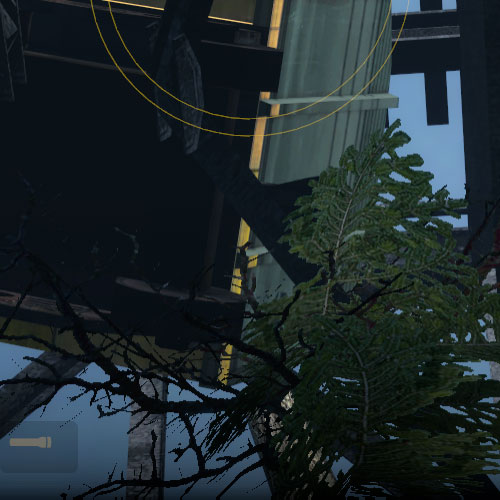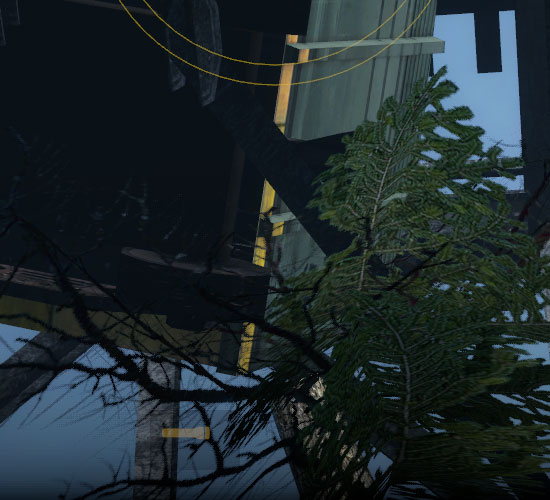AMD's Radeon HD 5870: Bringing About the Next Generation Of GPUs
by Ryan Smith on September 23, 2009 9:00 AM EST- Posted in
- GPUs
The Return of Supersample AA
Over the years, the methods used to implement anti-aliasing on video cards have bounced back and forth. The earliest generation of cards such as the 3Dfx Voodoo 4/5 and ATI and NVIDIA’s DirectX 7 parts implemented supersampling, which involved rendering a scene at a higher resolution and scaling it down for display. Using supersampling did a great job of removing aliasing while also slightly improving the overall quality of the image due to the fact that it was sampled at a higher resolution.
But supersampling was expensive, particularly on those early cards. So the next generation implemented multisampling, which instead of rendering a scene at a higher resolution, rendered it at the desired resolution and then sampled polygon edges to find and remove aliasing. The overall quality wasn’t quite as good as supersampling, but it was much faster, with that gap increasing as MSAA implementations became more refined.
Lately we have seen a slow bounce back to the other direction, as MSAA’s imperfections became more noticeable and in need of correction. Here supersampling saw a limited reintroduction, with AMD and NVIDIA using it on certain parts of a frame as part of their Adaptive Anti-Aliasing(AAA) and Supersample Transparency Anti-Aliasing(SSTr) schemes respectively. Here SSAA would be used to smooth out semi-transparent textures, where the textures themselves were the aliasing artifact and MSAA could not work on them since they were not a polygon. This still didn’t completely resolve MSAA’s shortcomings compared to SSAA, but it solved the transparent texture problem. With these technologies the difference between MSAA and SSAA were reduced to MSAA being unable to anti-alias shader output, and MSAA not having the advantages of sampling textures at a higher resolution.
With the 5800 series, things have finally come full circle for AMD. Based upon their SSAA implementation for Adaptive Anti-Aliasing, they have re-implemented SSAA as a full screen anti-aliasing mode. Now gamers can once again access the higher quality anti-aliasing offered by a pure SSAA mode, instead of being limited to the best of what MSAA + AAA could do.
Ultimately the inclusion of this feature on the 5870 comes down to two matters: the card has lots and lots of processing power to throw around, and shader aliasing was the last obstacle that MSAA + AAA could not solve. With the reintroduction of SSAA, AMD is not dropping or downplaying their existing MSAA modes; rather it’s offered as another option, particularly one geared towards use on older games.
“Older games” is an important keyword here, as there is a catch to AMD’s SSAA implementation: It only works under OpenGL and DirectX9. As we found out in our testing and after much head-scratching, it does not work on DX10 or DX11 games. Attempting to utilize it there will result in the game switching to MSAA.
When we asked AMD about this, they cited the fact that DX10 and later give developers much greater control over anti-aliasing patterns, and that using SSAA with these controls may create incompatibility problems. Furthermore the games that can best run with SSAA enabled from a performance standpoint are older titles, making the use of SSAA a more reasonable choice with older games as opposed to newer games. We’re told that AMD will “continue to investigate” implementing a proper version of SSAA for DX10+, but it’s not something we’re expecting any time soon.
Unfortunately, in our testing of AMD’s SSAA mode, there are clearly a few kinks to work out. Our first AA image quality test was going to be the railroad bridge at the beginning of Half Life 2: Episode 2. That scene is full of aliased metal bars, cars, and trees. However as we’re going to lay out in this screenshot, while AMD’s SSAA mode eliminated the aliasing, it also gave the entire image a smooth makeover – too smooth. SSAA isn’t supposed to blur things, it’s only supposed to make things smoother by removing all aliasing in geometry, shaders, and textures alike.
As it turns out this is a freshly discovered bug in their SSAA implementation that affects newer Source-engine games. Presumably we’d see something similar in the rest of The Orange Box, and possibly other HL2 games. This is an unfortunate engine to have a bug in, since Source-engine games tend to be heavily CPU limited anyhow, making them perfect candidates for SSAA. AMD is hoping to have a fix out for this bug soon.
“But wait!” you say. “Doesn’t NVIDIA have SSAA modes too? How would those do?” And indeed you would be right. While NVIDIA dropped official support for SSAA a number of years ago, it has remained as an unofficial feature that can be enabled in Direct3D games, using tools such as nHancer to set the AA mode.
Unfortunately NVIDIA’s SSAA mode isn’t even in the running here, and we’ll show you why.

5870 SSAA

GTX 280 MSAA

GTX 280 SSAA
At the top we have the view from DX9 FSAA Viewer of ATI’s 4x SSAA mode. Notice that it’s a rotated grid with 4 geometry samples (red) and 4 texture samples. Below that we have NVIDIA’s 4x MSAA mode, a rotated grid with 4 geometry samples and a single texture sample. Finally we have NVIDIA’s 4x SSAA mode, an ordered grid with 4 geometry samples and 4 texture samples. For reasons that we won’t get delve into, rotated grids are a better grid layout from a quality standpoint than ordered grids. This is why early implementations of AA using ordered grids were dropped for rotated grids, and is why no one uses ordered grids these days for MSAA.
Furthermore, when actually using NVIDIA's SSAA mode, we ran into some definite quality issues with HL2: Ep2. We're not sure if these are related to the use of an ordered grid or not, but it's a possibility we can't ignore.
If you compare the two shots, with MSAA 4x the scene is almost perfectly anti-aliased, except for some trouble along the bottom/side edge of the railcar. If we switch to SSAA 4x that aliasing is solved, but we have a new problem: all of a sudden a number of fine tree branches have gone missing. While MSAA properly anti-aliased them, SSAA anti-aliased them right out of existence.
For this reason we will not be taking a look at NVIDIA’s SSAA modes. Besides the fact that they’re unofficial in the first place, the use of a rotated grid and the problems in HL2 cement the fact that they’re not suitable for general use.












327 Comments
View All Comments
T2k - Thursday, September 24, 2009 - link
Just whatF are you talking about, seriously? Is this some kind of new urban BS again?
Look at other sites, they DID test it with ET:QW:
http://www.techpowerup.com/reviews/ATI/Radeon_HD_5...">http://www.techpowerup.com/reviews/ATI/Radeon_HD_5...
http://www.xbitlabs.com/articles/video/display/rad...">http://www.xbitlabs.com/articles/video/display/rad...
and so on. BTW L4D is a passing fart in the wind while ET:QW is still going strong, stronger than UT3 (unfortunately because UT3 looks 10x better and the old ONS mode was awesome but Epic fucked it in UT3)
Read other reviews before you post:
http://forums.anandtech.com/messageview.aspx?catid...">http://forums.anandtech.com/messageview...amp;thre...
SiliconDoc - Wednesday, September 30, 2009 - link
I see by your review links the 5870 just doesn't do well in ET:QW, everything else is closer to it and it gets beat worse, at 2560 high aa&af GTX295 slams it by 20%, so, of course, it was left out, in order to "pump up the percieved red number".-
It's "not a good appearance".
You'll just have to live with it for now like the rest of us.
number58 - Wednesday, September 23, 2009 - link
Is this card any closer to saturating the pci-express 2.0 x16 slot? That was one of the big arguments in the P55 vs X58 debate. Would there be any loss of performance using these in crossfire on P55 compared to X58?Otherwise, great article. I think I'll be hanging on to my 4890 for a while though.
Kaleid - Wednesday, September 23, 2009 - link
Look here for an answer:http://www.techpowerup.com/reviews/AMD/HD_5870_PCI...">http://www.techpowerup.com/reviews/AMD/HD_5870_PCI...
number58 - Wednesday, September 23, 2009 - link
Thanks. That just about settles it. My next system will be Lynnfield based.Zeratul - Wednesday, September 23, 2009 - link
Please add support for Stereoscopic 3D, ATI. I'm not going back to play games in 2D, though I don't like nvidia's monopoly in that.Arbie - Wednesday, September 23, 2009 - link
Not just a review but an excellent technical discussion. It must have been a lot of work. Thanks for all of that, and do please follow up where you can on people's requests for more info on this very important card.Kudos to ATI/AMD for such an achievement. It looks like Nvidia is in big trouble.
Arbie
SiliconDoc - Wednesday, September 23, 2009 - link
rofl - Nvidia is in big trouble ? LOLHave you looked at the charts on wiki that predicted what this review shows ? Maybe you should take a gander at the Nvidia chart, now, and cry.
--
It is a nice review, although biased red here as usual.
--
I'd like to mention as he fretted about heat because of the 1/2 vent on the back of the card, I didn't notice overt despairing mention of the TWO rectangular exhaust ports on the fan end BLOWING HEAT INTO THE CASE.... which of course is deserved. Nice how that was held back as if overlooked. (Boy what trouble for Nvidia! hahha)
Next we'll be told the red rooster tester put his hand next to the two internal exhaust ports, and "the air felt rather cool" so "rest assured not much heat is being pushed into your case", and "this doesn't matter".
See, the trouble is already in the article, the trouble it took to spin it just so for Ati... lol... it's hilatrious!
ClownPuncher - Wednesday, September 23, 2009 - link
Bizzarro SnakeOil, is that you?SiliconDoc - Wednesday, September 23, 2009 - link
No, this is me, the same me I've always been.Would you like to comment on the two internal exhaust ports of the 5870 that put sweltering heat into your case ?
I guess you tried to ignore that entirely.
You can always insult me again and avoid commenting on the heating exhaust ports ramping up your case temps on the 5870...
That of course would be "the right thing to do".
Perhaps call me crazy, and avoid the topic, right, you're good at that, huh.